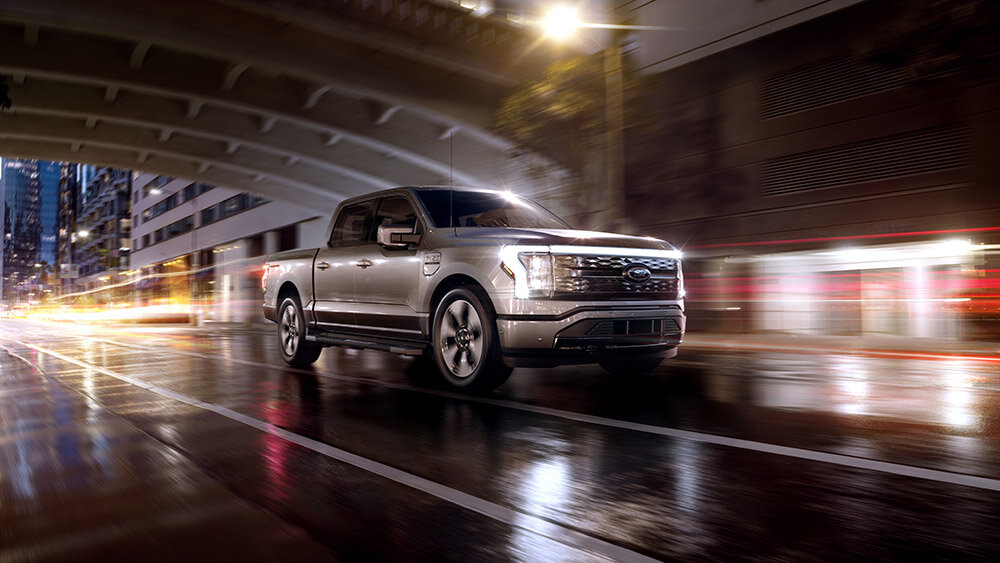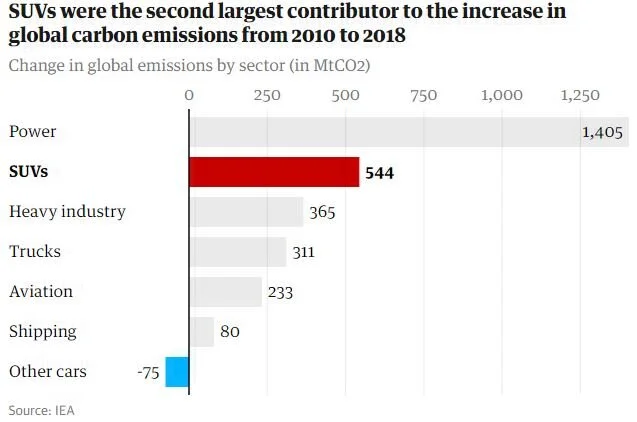
Ford’s Electric Pickup Highlights An Unjust Climate Transition
Owing to the influence of President Joe Biden, the launch of Ford’s new all-electric F-150 Lightning pickup truck has garnered much media attention as the American automotive giant slowly starts to turn its attention to electric vehicles.
Yet, while much of the coverage about the launch of the F-150 Lightning has been positive and lauded the arrival of more electric vehicle options, it has significantly overlooked the road safety and climate dangers posed by SUVs and pickup trucks.
Today we look at what Ford’s latest product means for US emissions, and how it is holding back a just climate transition.
Just Transition
When we talk about a just transition, we mean the introduction of legislation that will benefit everyone as we seek to lower greenhouse gas emissions in order to tackle the Climate Crisis.
While many of us will think about our own carbon footprint – or that of our home nation – the idea of a just transition means that we need to consider the impact for all societies worldwide.
Crucial to this is considering the role of the Global South – typically lower income countries which have historically had the lowest carbon footprints, and which are most vulnerable in the face of the Climate Crisis.
This is where the F-150 Lightning and America’s love affair with large, heavy SUVs comes in.
In 2018, the US had just 4% of the world’s total population, and yet it consumed 17% of the world’s total energy production.
By continuing to commit to producing large, heavy vehicles the US is committing to consuming more than its fair share of energy. While electric vehicles are considerably more energy efficient than their internal combustion engine counterparts (EVs convert ~60% of their energy into propulsion, while ICEs convert just 17-21% of their fuel into power), making EVs unnecessarily heavy reduces their efficiency, in the same way that it does for a petrol or diesel car.
If SUV drivers were a single nation, it would rank as the 7th largest emitter of CO2 in the world. Credit: The Guardian
The Ford F-150 Lightning is expected to weigh 6,500lbs according to Motortrend. Compare this to the weight of a European SUV such as the VW ID4, at 4,517lbs, or a typical non-SUV car such as the VW ID3, at 3,527lbs, and you’ll soon see that American SUVs and pick-ups weigh twice the weight of a typical European vehicle.
This either means vastly higher levels of energy consumption – meaning more investment in renewable energy, or the consumption of more fossil fuels to produce electricity – a reduction in performance and range, or the production of larger batteries to make up for the shortfall in range due to weight.
Again, the latter does not represent a just transition, as the US would be consume more than its fair share of batteries and drive greater exploitation of people and land in order to produce them.
It is also important to remember that SUVs and pickups are only popular in the US due to considerable tax concessions, and that their classification allowed manufacturers to avoid fuel economy regulations.
President Joe Biden, who stands 5ft 9in tall - the average height for an American male - demonstrates the safety concerns of SUVs and pickup trucks, with the majority of his vital organs in line with the hood/bonnet of the Ford F-150 Lightning, leading to a higher likelihood of death in a collision. Credit: Ford
Their aggressive marketing in the US has subsequently lead to a rising popularity elsewhere, with Reuters reporting that global SUV sales rose from 35 million in 2010 to 200 million in 2020, accounting for more than 60% of the increase in global car sales in the past decade.
Better Than The Alternative?
This rise in SUV sales has also driven an alarming rise in the amount of greenhouse gas emissions produced by cars – see our article SUVs Are Killing The Planet.
A 2019 study by the International Energy Agency found that SUVs were the second largest cause of the global rise in carbon dioxide emission over the past decade – contributing considerably more than all aviation, shipping and heavy industry outputs.
To put this into context, each year SUVs emit 700 megatonnes of CO2 – equivalent to the entire output of the UK and the Netherlands combined. In fact, if SUV drivers were a single nation, it would rank as the seventh largest emitter in the world.
With Ford typically selling 900,000 F-Series trucks per year, the introduction of an electric alternative to the highly-polluting ICE version could help the US to make a dent in its rising automotive emissions.
This is reinforced by Ford’s plans to stop selling ICE vehicles by 2035 – albeit that this is considerably later than many countries are due to ban the sale of non-electric vehicles, with Ireland committed to ending petrol and diesel sales in 2030.
Yet, even if the F-150 Lightning does contribute to offsetting the emissions of some of the worst-polluting vehicles on the road – and that’s a big if – it still does not address the major road safety concerns of such vehicles, especially with a vehicle that stands 6 foot 4 inches (1.9 meters) tall.
While the majority of road vehicles are designed with the safety of pedestrian collisions in mind – trying to send them over the car in the safest possible manner – SUVs are most likely to impact pedestrians and cyclists in their vital organs, resulting in either instant death, or dragging them under the car, where chances of survival are at their lowest.
To illustrate this, a 2020 study by the Insurance Institute for Highway Safety found that 100% of pedestrians in SUV collisions at speeds of 40mph (64kph) or greater died, versus 54% who were struck by more smaller, more traditional cars.
In the US, the National Highway Traffic Safety Administration found that pedestrian deaths from SUVs have risen by 81% in the past decade. Unfortunately no data for the safety implications of SUVs in Ireland is available, as such studies have not been undertaken to date.
By committing to the continuation of energy inefficient vehicles like SUVs and heavy pickups, the US is committing to an unjust climate transition. In 2018, the US was one of the highest CO2 emitters per capita, producing 16.1 tons per person - compared to 7.7 tons in Ireland. Credit: Wikipedia
As such, by committing to the continuation of these heavy, oversized vehicles – and using the incumbent President to promote them – the US is committing to a highly unjust climate transition that will only further exacerbate the gulf between rich and poor nations, while putting the safety of their own citizens at even greater jeopardy.
In the interests of road safety and achieving sufficient greenhouse gas emissions reductions, we would support a ban on the sale of SUVs alongside the sale of ICE vehicles.
What To Read Next
SUVs Are Killing The Planet
SUVs are twice as likely to kill a pedestrian in a collision and are the second largest cause of the global rise in carbon dioxide emission over the past decade
What GM’s Pledge Means For EVs
Discover what GM's electric car pledge means for the future of EVs, the Climate Crisis – and how GM could have kick-started the EV revolution in the 1990s






